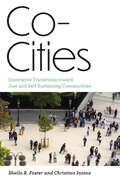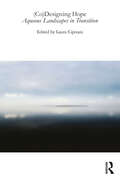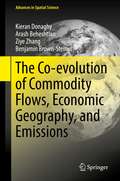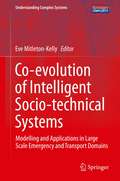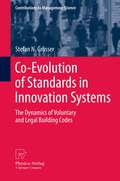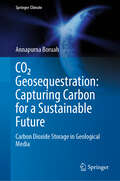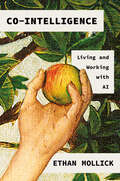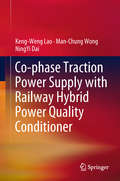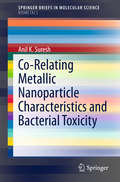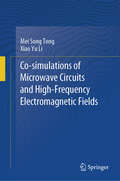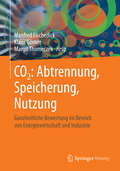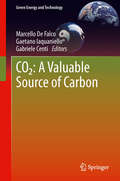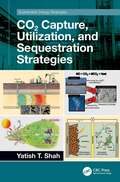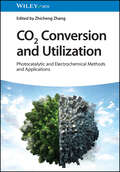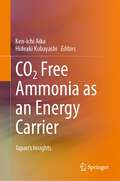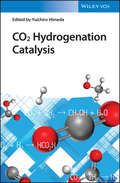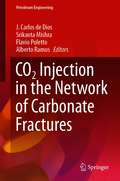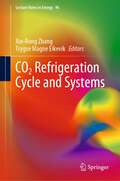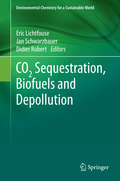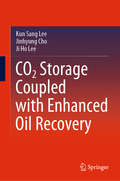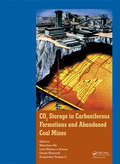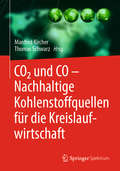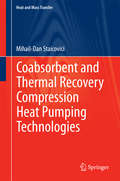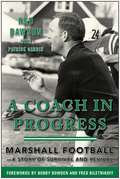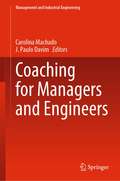- Table View
- List View
Co-Cities: Innovative Transitions toward Just and Self-Sustaining Communities (Urban and Industrial Environments)
by Sheila R. Foster Christian IaioneA new model of urban governance, mapping the route to a more equitable management of a city&’s infrastructure and services.The majority of the world&’s inhabitants live in cities, but even with the vast wealth and resources these cities generate, their most vulnerable populations live without adequate or affordable housing, safe water, healthy food, and other essentials. And yet, cities also often harbor the solutions to the inequalities they create, as this book makes clear. With examples drawn from cities worldwide, Co-Cities outlines practices, laws, and policies that are presently fostering innovation in the provision of urban services, spurring collaborative economies as a driver of local sustainable development, and promoting inclusive and equitable regeneration of blighted urban areas. Identifying core elements of these diverse efforts, Sheila R. Foster and Christian Iaione develop a framework for understanding how certain initiatives position local communities as key actors in the production, delivery, and management of urban assets or local resources. Within this framework, they explain the forms such initiatives increasingly take, like community land trusts, new kinds of co-housing, neighborhood cooperatives, community-shared broadband and energy networks, and new local offices focused on citizen science and civic imagination. The &“Co-City&” framework is uniquely rooted in the authors&’ own decades-long research and first-hand experience working in cities around the world. Foster and Iaione offer their observations as &“design principles&”—adaptable to local context—to help guide further experimentation in building just and self-sustaining urban communities.
(Co)Designing Hope: Aqueous Landscapes in Transition
by Laura CiprianiExtreme weather events, droughts, floods, shifts in precipitation and temperature patterns, melting glaciers, sea-level rise, water salinization, and more generally, changes in the water cycle remind us that the climate crisis is mostly a water crisis. Perhaps even more serious is a crisis of imagination connected with thought and with creative, far-sighted action able to combine the visionary and the pragmatic. A response to these two crises can be provided by the disciplines of landscape architecture: these have always featured a plural, collective approach that comprises or originates from living systems and natural forces, on the involvement of human and nonhuman communities in the design process, and the inclusion of the time variable in future plans—without neglecting the necessary flexibility of creative and pragmatic thinking. How can landscape design and different forms of collaboration open new doors to face climate and water challenges? What hopes can spring from collective design in its broader meaning?This book sets out notions and ideas on water landscapes and (co)designed practices, identifying what hopeful routes might be taken for the three states of aqueous landscapes in transition—liquid, solid, and gas. The chapters show different scales and levels of design and collaborative practices: from large and governmental projects to small bottom-up interventions; from creative collaboration among designers to traditional community design; from participatory processes to nature as a co-designer for tackling the climate crisis. People, animals, plants, water, ice, fog, clouds, wind, sand, and rocks—all contribute to the cosmos’ landscape symphony, and designing together can become a seed of hope to listen and embrace the Earth’s climate changes.
The Co-evolution of Commodity Flows, Economic Geography, and Emissions (Advances in Spatial Science)
by Kieran Donaghy Arash Beheshtian Ziye Zhang Benjamin Brown-SteinerThis book presents extensions to current commodity-flow models to analyze the economic and environmental impacts of recent structural changes, such as fragmentation of production and lengthening supply chains. The extensions enable augmented commodity-flow models to analyze the vulnerability of supply chains and regions to climate change and extreme weather events. The models allow the explicit treatment of trade in intermediate goods; the so-called “new economic geography” behavioral foundations for production and inter-industry and interregional trade; endogenous determination of capital investment and employment; and changes in emissions associated with production, consumption and freight movement. Presenting a modeling framework and simulations that are based on a thirty-year, spatial time-series of inter-industry and interstate trade in the US, this unique book is a valuable resource for regional scientists, economic geographers and transportation modelers, as well as environmental and atmospheric scientists.
Co-evolution of Intelligent Socio-technical Systems: Modelling and Applications in Large Scale Emergency and Transport Domains (Understanding Complex Systems)
by Evangelia Mitleton-KellyAs the interconnectivity between humans through technical devices is becoming ubiquitous, the next step is already in the making: ambient intelligence, i.e. smart (technical) environments, which will eventually play the same active role in communication as the human players, leading to a co-evolution in all domains where real-time communication is essential. This topical volume, based on the findings of the Socionical European research project, gives equal attention to two highly relevant domains of applications: transport, specifically traffic, dynamics from the viewpoint of a socio-technical interaction and evacuation scenarios for large-scale emergency situations. Care was taken to investigate as much as possible the limits of scalability and to combine the modeling using complex systems science approaches with relevant data analysis.
Co-Evolution of Standards in Innovation Systems: The Dynamics of Voluntary and Legal Building Codes (Contributions to Management Science)
by Stefan N. GrösserMitigating climate change is one of the most profound challenges facing humankind. In industrialized countries, the residential housing sector produces roughly one-fourth of the greenhouse gas emissions. One solution to reduce these emissions is the availability of building codes that require high levels of energy efficiency. Given the current scientific knowledge, more research is needed to gain a proper systemic understanding of the underlying socio-economic and technical system. Such an understanding is crucial for developing high energy-efficiency standards because this system develops gradually over time and cannot be changed swiftly. This book creates a feedback-rich simulation model for analyzing the effects of different administrative policies on energy demand, the improvement of energy efficiency by means of building codes, and reductions in the greenhouse gas emissions. The dynamic model can contribute substantially to the discourse on energy policies and guide effective administrative interventions. The book will be a valuable resource for officials in the public energy administration, as well as researchers in the areas of innovation, diffusion processes, co-evolution, standardization, and simulation modelling.
CO₂ Geosequestration: Carbon Dioxide Storage in Geological Media (Springer Climate)
by Annapurna BoruahAs the world faces the urgent need to combat climate change, "CO2 Geosequestration: Capturing Carbon for a Sustainable Future" provides a comprehensive solution on carbon dioxide storage in geological media, and utilization to reduce the CO2 from the atmosphere. This book serves as a guide to understanding the science and technology for carbon dioxide geosequestration. In this engaging guide, the author delves into innovative methods and processes designed to securely store CO2 emissions from various sources. With a focus on environmental sustainability, the book explores the geological storage of carbon dioxide in depleted oil and gas reservoirs, coal, shale, saline aquifers, basalt, and other underground formations, ensuring that this remains safely sequestered for the long term. Through a blend of real-world case studies, cutting-edge research, and expert insights, CO2 Geosequestration highlights the potential of this technology to mitigate greenhouse gas emissions and reduce the carbon footprint of industries worldwide. From the basics of carbon capture to the intricate details of monitoring and verification, this book offers an in-depth look at the challenges, opportunities, and prospects of CO2 geosequestration. Whether you are a scientist, engineer, policymaker, or environmentally conscious individual, this book provides a valuable resource for understanding the fundamental principles and potential benefits of geosequestration in the fight against climate change. Join us on a journey toward a sustainable future where carbon capture and geosequestration play critical roles in protecting our planet for generations to come.
Co-Intelligence: Living and Working With AI
by Ethan MollickFrom Wharton professor and author of the popular One Useful Thing Substack newsletter Ethan Mollick comes the definitive playbook for working, learning, and living in the new age of AI <p><p> Something new entered our world in November 2022 — the first general purpose AI that could pass for a human and do the kinds of creative, innovative work that only humans could do previously. Wharton professor Ethan Mollick immediately understood what ChatGPT meant: after millions of years on our own, humans had developed a kind of co-intelligence that could augment, or even replace, human thinking. Through his writing, speaking, and teaching, Mollick has become one of the most prominent and provocative explainers of AI, focusing on the practical aspects of how these new tools for thought can transform our world. <p><p> In Co-Intelligence, Mollick urges us to engage with AI as co-worker, co-teacher, and coach. He assesses its profound impact on business and education, using dozens of real-time examples of AI in action. Co-Intelligence shows what it means to think and work together with smart machines, and why it’s imperative that we master that skill. <p><p> Mollick challenges us to utilize AI’s enormous power without losing our identity, to learn from it without being misled, and to harness its gifts to create a better human future. Wide ranging, hugely thought-provoking, optimistic, and lucid, Co-Intelligence reveals the promise and power of this new era. <p> <b>New York Times Bestseller</b>
Co-phase Traction Power Supply with Railway Hybrid Power Quality Conditioner
by NingYi Dai Man-Chung Wong Keng-Weng LaoThis book offers a brief review of and investigations into the power quality problem in the new technology of co-phase high-speed traction power supplies, which benefits for higher locomotive speed. In addition, it presents detailed design procedures and discusses the chief concerns in connection with a newly proposed solution: compensation in co-phase traction power using a co-phase railway hybrid power quality conditioner (Railway HPQC). Further, it provides essential information on the modeling of power quality in co-phase, high-speed traction power supplies, and on power quality compensation algorithm derivations. Lastly, it delineates the design of railway HPQC and analyzes the effect of different parameters on its performance to accommodate different priorities. All design is supported by simulations and the results of experimental verification.
Co-Relating Metallic Nanoparticle Characteristics and Bacterial Toxicity (SpringerBriefs in Molecular Science)
by Anil K. SureshThis brief gives a concise overview of nanoparticles and their microbial toxicity. It introduces various nanoparticles that are considered lethal to microbial cells (bacteria, virus and fungus) placing an emphasis on metal and metal oxide nanoparticles. The synthesis procedures (physical, chemical, microbial) that are often employed in their fabrication are also outlined. The interaction of various nanoparticles with microbes is described with attention given to the role of additives in the form of solvents, surfactants, capping materials. Commonly used experimental and analytical techniques that are often used to evaluate and determine the toxicity of nanoparticles towards different microorganisms are presented and comparative assessments on the differences between these procedures are described. The brief ends by explaining the toxicity of metal and metal oxide nanoparticles to microorganisms.
Co-simulations of Microwave Circuits and High-Frequency Electromagnetic Fields
by Mei Song Tong Xiao Yu LiThis book aims to provide many advanced application topics for microwave circuits and high-frequency electromagnetic (EM) fields by using advanced design system (ADS) and high-frequency structure simulator (HFSS) as simulation platforms. In particular, it contains the latest multidisciplinary co-simulation guidance on the design of relevant components and devices. Currently, the circuit/field design and performance analysis and optimization strongly rely on various kinds of robust electronic design automation (EDA) software. RF/microwave engineers must grasp two or more types of related simulation design software. ADS by Keysight and HFSS by Ansys are the representative for circuit simulations and for field and structural simulations of microwave devices, respectively. At present, these two types of software are widely used in enterprises, universities, and research institutions. The main purpose of this book is to enable readers, who are interested in microwave engineering and applied electromagnetics, to master the applications of these two tools. It also helps readers expand their knowledge boundaries behind those types of software and deepen their understanding of developing interdisciplinary technologies by co-simulations. The book is divided into three parts. The first part introduces the two latest versions of ADS and HFSS and helps readers better understand the basic principles and latest functions better. It also advises how to choose appropriate simulation tools for different problems. The second part mainly describes co-simulations for high-frequency EM fields, microwave circuits, antenna designs, EM compatibility (EMC), and thermal and structural analyses. It provides guides and advices on performing co-simulations by ADS and HFSS incorporated with other types of software, respectively. The last part narrates the automation interfaces and script programming methods for co-simulations. It primarily deals with the Advanced Extension Language (AEL), Python Data Link (PDL), and MATLAB interface in ADS. For HFSS, it discusses VBScript, IronPython scripting, and Application Programming Interface (APIs) based on MATLAB. Each topic contains practical examples to help readers understand so that they can gain a solid knowledge and skills regarding automated interfaces and scripting methods based on these kinds of software. Concisely written in combination with practical examples, this book is very suitable as a textbook in introductory courses on microwave circuit and EM simulations and also as a supplementary textbook in many courses on electronics, microwave engineering, communication engineering, and related fields. As well, it can serve as a reference book for microwave engineers and researchers.
CO2: Ganzheitliche Bewertung im Bereich von Energiewirtschaft und Industrie
by Manfred Fischedick Klaus Görner Margit ThomeczekAusgehend von den naturwissenschaftlichen und technischen Grundlagen werden in dem Band Technologien zur Abscheidung, Speicherung und Nutzung von klimasch#65533;dlichem CO2 vorgestellt. Der Stand der Technik wird dargelegt, die Energiebilanzen verschiedener Techniken verglichen, rechtliche, wirtschaftliche und gesellschaftspolitische Aspekte beschrieben und dar#65533;ber hinaus die Standpunkte der verschiedenen Interessengruppen vorgestellt. Um sachlich informieren zu k#65533;nnen, legen die Autoren die Kriterien f#65533;r die Bewertung der einzelnen Sichtweisen offen.
CO2: A Valuable Source Of Carbon (Green Energy and Technology)
by Gaetano Iaquaniello Marcello De Falco Gabriele CentiAs the annual production of carbon Dioxide (CO2) reaches 30 billion tones, the growing issue of the greenhouse effect has triggered the development of technologies for CO2 sequestration, storage and use as a reactant. Collecting together the reports of the Congress at University of Rome (Campus Bio-medico) held 16th April 2012, CO2: A Valuable Source of Carbon presents and discusses promising technologies for the industrial exploitation of CO2. Divided into two parts, the current technology is evaluated and summarized before European and national projects are presented. The focus on CO2 recovery, particularly in value-added production, proposes applicable methods to develop sustainable practices and even to mitigate greenhouse gas emission from large-scale fossil fuels usage. Including current data and real-world examples, CO2: A valuable source of carbon provides students, engineers, researchers and industry professional with up-to-date material and potential areas for development and research.
CO2 Capture, Utilization, and Sequestration Strategies (Sustainable Energy Strategies)
by Yatish T. ShahOffering practical treatment strategies for CO2 emission generated from various energy-related sources, CO2 Capture, Utilization, and Sequestration Strategies emphasizes carbon capture, utilization, and sequestration (CCUS) with special focus on methods for each component of the strategy. While other books mostly focus on CCS strategy for CO2, this book details the technologies available for utilization of CO2, showing how it can be a valuable renewable source for chemicals, materials, fuels, and power instead of a waste material damaging the environment. Highlights current and potential future commercially viable CCUS strategies Discusses applications for direct and the more complex indirect utilization of CO2 streams Examines viability of the mineral carbonation process and biological treatments to convert CO2 into useful biochemicals, biomaterials, and biofuels Explores heterogeneous catalysis for thermal and electrochemical conversion and solar energy-based thermal, photo-thermal, and photocatalytic conversion of CO2 Presents the rapidly growing concept of plasma-activated catalysis for CO2 conversion CO2 Capture, Utilization, and Sequestration Strategies is a valuable reference for researchers in academia, industry, and government organizations seeking a guide to effective CCUS processes, technologies, and applications.
CO2 Conversion and Utilization: Photocatalytic and Electrochemical Methods and Applications
by Zhicheng ZhangCO2 Conversion and Utilization Comprehensive overview of current development of various catalysts in CO2 conversion and utilization through photocatalytic and electrochemical methods CO2 Conversion and Utilization systematically summarizes the development of CO2 photo- and electro-conversion and utilization, especially the reaction mechanism, engineering and technology of testing, and preparation methods and physicochemical properties of various catalytic materials. The rational design and preparation of catalysts, development of characterization technologies, and in-depth understanding of catalytic mechanisms are systematically discussed. In particular, the various parameters influencing the photocatalytic and electrochemical CO2 reduction are emphasized. The underlying challenges and perspectives for the future development of efficient catalysts for CO2 reduction to specific chemicals and fuels are discussed at the end of the text. Written by a highly qualified author with significant experience in the field, CO2 Conversion and Utilization includes information on: Measurement systems and parameters for CO2 photo/electro-conversion, CO2 photo/electro-conversion mechanism, and Cu-based and Cu-free metal materials for electrocatalytic CO2 reduction Organic-inorganic, metal organic framework, and covalent organic framework hybrid materials for CO2 photo/electro-conversion Single/dual-atom catalysts, homogeneous catalysts, and high-entropy alloys for CO2 photo/electro-conversion Semiconductor composite and carbon-based materials for photocatalytic CO2 reduction, novel routes for CO2 utilization via metal-CO2 batteries, and CO2 conversion into long-chain compounds Providing comprehensive coverage of the subject, CO2 Conversion and Utilization is of high interest for scientific researchers as well as engineers and technicians in industry, including but not limited to photochemists, electrochemists, environmental chemists, catalytic chemists, chemists in industry, and inorganic chemists.
CO2 Free Ammonia as an Energy Carrier: Japan's Insights
by Ken-Ichi Aika Hideaki KobayashiThis book describes important findings in intensive studies conducted in Japan on ammonia as an energy carrier. It illustrates an advanced solar-heat capture system and storage materials at 600°C and hydrogen production with SOECs and a new IS method through the use of heat. New industrial ammonia catalysts and a demonstration process that started running in Fukushima are also introduced. Advanced ammonia decomposition catalysts and the process that were developed for use by the hydrogen station are presented. An advanced direct ammonia fuel cell was developed and the base data are shown. The book explains that ammonia is used as a fuel for industrial applications because its burning can be controlled without emitting extra NOx in the gas turbine and the real coal co-fired power plant. These breakthroughs have made a strong impact in the world as a practical technology for CO2 reduction. Also provided here are the scientific and industrial backgrounds as well as the environmental assessment and economic evaluation for the future.This book will be helpful for all who are interested in energy technology—researchers, students, and strategy planners at companies and in the government.
CO2 Hydrogenation Catalysis
by Yuichiro HimedaA guide to the effective catalysts and latest advances in CO2 conversion in chemicals and fuels Carbon dioxide hydrogenation is one of the most promising and economic techniques to utilize CO2 emissions to produce value-added chemicals. With contributions from an international team of experts on the topic, CO2 Hydrogenation Catalysis offers a comprehensive review of the most recent developments in the catalytic hydrogenation of carbon dioxide to formic acid/formate, methanol, methane, and C2+ products. The book explores the electroreduction of carbon dioxide and contains an overview on hydrogen production from formic acid and methanol. With a practical review of the advances and challenges in future CO2 hydrogenation research, the book provides an important guide for researchers in academia and industry working in the field of catalysis, organometallic chemistry, green and sustainable chemistry, as well as energy conversion and storage. This important book: Offers a unique review of effective catalysts and the latest advances in CO2 conversion Explores how to utilize CO2 emissions to produce value-added chemicals and fuels such as methanol, olefins, gasoline, aromatics Includes the latest research in homogeneous and heterogeneous catalysis as well as electrocatalysis Highlights advances and challenges for future investigation Written for chemists, catalytic chemists, electrochemists, chemists in industry, and chemical engineers, CO2 Hydrogenation Catalysis offers a comprehensive resource to understanding how CO2 emissions can create value-added chemicals.
CO2 Injection in the Network of Carbonate Fractures (Petroleum Engineering)
by J. Carlos de Dios Srikanta Mishra Flavio Poletto Alberto RamosThis book presents guidelines for the design, operation and monitoring of CO2 injection in fractured carbonates, with low permeability in the rock matrix, for geological storage in permanent trapping. CO2 migration is dominated by fractures in formations where the hydrodynamic and geochemical effects induced by the injection play a key role influencing the reservoir behavior. CO2 injection in these rocks shows specific characteristics that are different to injection in porous media, as the results from several research studies worldwide reveal. All aspects of a project of this type are discussed in this text, from the drilling to the injection, as well as support works like well logging, laboratory and field tests, modeling, and risk assessment. Examples are provided, lesson learned is detailed, and conclusions are drawn. This work is derived from the experience of international research teams and particularly from that gained during the design, construction and operation of Hontomín Technology Development Plant. Hontomín research pilot is currently the only active onshore injection site in the European Union, operated by Fundación Ciudad de la Energía-CIUDEN F.S.P. and recognized by the European Parliament as a key test facility. The authors provide guidelines and tools to enable readers to find solutions to their problems. The book covers activities relevant to a wide range of practitioners involved in reservoir exploration, modeling, site operation and monitoring. Fluid injection in fractured media shows specific features that are different than injection in porous media, influencing the reservoir behavior and defining conditions for safe and efficient operation. Therefore, this book is also useful to professionals working on oil & gas, hydrogeology and geothermal projects, and in general for those whose work is related to activities using fluid injection in the ground.
CO2 Refrigeration Cycle and Systems (Lecture Notes in Energy #96)
by Xin-Rong Zhang Trygve Magne EikevikThis book covers the fundamentals and applications of carbon dioxide vapor compression refrigeration thermodynamic cycles. In particular, it presents new application areas, such as making ice and snow in the Winter Olympic Games, food cooling and refrigeration. The book explores the physical and chemical characteristics of CO2 fluid, and the unique traits of its thermodynamic cycle. The contributors explain how CO2 refrigeration is a developing, eco-friendly technology, and emphasize its importance for refrigeration and air-conditioning in the current and future market.This book is a valuable source of information for researchers, engineers and policy makers looking to expand their applicable knowledge of high-potential refrigeration technology using carbon dioxide. It is also of interest to postgraduate students and practitioners looking for an academic insight into the industry’s latest eco-friendly technologies.
CO2 Sequestration, Biofuels and Depollution (Environmental Chemistry for a Sustainable World #5)
by Eric Lichtfouse Jan Schwarzbauer Didier RobertWater is the driving force of all nature. This old quote from Leonardo da Vinci reminds us that without water life is simply not possible. As a consequence, water is probably the most important wealth for humanity. In spite of this, drinking water is still polluted by man-made toxicals gathered by waters in soils and the atmosphere. This book presents advanced methods to clean water and air. Chapters also focus on biofuels, greenhouse gases and genetically modified crops.
CO2 Storage Coupled with Enhanced Oil Recovery
by Kun Sang Lee Jinhyung Cho Ji Ho LeeThis book provides a comprehensive and detailed description of the various mechanisms of the CCS–EOR process. Whereas previous texts have primarily focused on carbon capture and storage (CCS) and enhanced oil recovery (EOR) separately, this book provides a general overview of both technologies when used together. Coupled CCS–EOR technology has become increasingly important, as it overcomes the respective shortcomings of the two technologies. The book presents an integrated numerical model including the hysteresis effect, solubility trapping, miscibility, and formation damage by asphaltene deposition. The experimental and model-based evaluation of fluid properties is also discussed. The book concludes by discussing the latest research into CO2 storage coupled with EOR, most notably performance control by including additives in CO2 injection, and CO2 injection into shale reservoirs. Ideally suited for graduate students and researchers in the fields of carbon capture, utilisation, and storage, the book shares essential insights into maximising the efficiency of CCS and EOR alike.
CO2 Storage in Carboniferous Formations and Abandoned Coal Mines
by Manchao He Luis Ribeiro e Sousa Derek Elsworth Euripedes VargasUnderground geological storage of carbon dioxide (CO2) has considerable potential for mitigating climate change. CO2 can be safely injected and stored at well characterized and properly managed sites. Injecting carbon dioxide in deep geological formations can store it underground for long periods of time. Depleted oil and gas reservoirs, saline aqu
CO2 und CO – Nachhaltige Kohlenstoffquellen für die Kreislaufwirtschaft
by Manfred Kircher Thomas SchwarzKlimaschutz und Rohstoffwandel erfordern für die Chemie- und Treibstoffindustrie neue, nachhaltige Kohlenstoffquellen. Tatsächlich erreichen Verfahren, die kohlenstoffhaltige Emissions- und Gasströme industriell verwerten, die industrielle Praxis. Sie werden auch in Europa einen wichtigen Beitrag zur Senkung der Kohlenstoff-Emission und für den Einstieg in eine echte Kohlenstoff-Kreislaufwirtschaft leisten.Dieses Buch beschreibt die Grundlagen chemischer und biotechnologischer Verfahren zur Umsetzung von CO und CO2 zu Chemikalien und Treibstoffen und geht auf das Potential für die produzierende Wirtschaft, Industriestandorte und Regionen ein:Welche Emissions- und Gasströme bieten Rohstoffpotential? Welche Verfahren werden bereits implementiert, werden geprüft und sind in Entwicklung?Welche Produkte können aus gasförmigen Kohlenstoffquellen hergestellt werden?Wie können Kohlenstoff abgebende und verbrauchende Industrien zu neuen Wertschöpfungsketten verknüpft werden?Wie sehen die regulatorischen Rahmenbedingungen aus?Wie sieht der ökologische Fußabdruck aus?Wie tragen die neuen Verfahren zur regionalen Wirtschaft bei und unterstützen damit die gesellschaftliche Akzeptanz?
Coabsorbent and Thermal Recovery Compression Heat Pumping Technologies (Heat and Mass Transfer)
by Mihail-Dan StaicoviciThis book introduces two of the most exciting heat pumping technologies, the coabsorbent and the thermal recovery (mechanical vapor) compression, characterized by a high potential in primary energy savings and environmental protection. New cycles with potential applications of nontruncated, truncated, hybrid truncated, and multi-effect coabsorbent types are introduced in this work Thermal-to-work recovery compression (TWRC) is the first of two particular methods explored here, including how superheat is converted into work, which diminishes the compressor work input. In the second method, thermal-to-thermal recovery compression (TTRC), the superheat is converted into useful cooling and/or heating, and added to the cycle output effect via the coabsorbent technology. These and other methods of discharge gas superheat recovery are analyzed for single-, two-, three-, and multi-stage compression cooling and heating, ammonia and ammonia-water cycles, and the effectiveness results are given. The author presents absorption-related topics, including the divided-device method for mass and heat transfer analysis, and truncation as a unique method for a better source-task match. Along with advanced gax recovery, the first and second principles of COP and exergy calculation, the ideal point approaching (i. p. a. ) effect and the two-point theory of mass and heat transfer, the book also addresses the new wording of the Laplace equation, the Marangoni effect true explanation, and the new mass and heat exchangers based on this effect The work goes on to explore coabsorbent separate and combined cooling, heating, and power (CHP) production and advanced water-lithium bromide cycle air-conditioning, as well as analyzing high-efficiency ammonia-water heat-driven heating and industrial low-temperature cooling, in detail Readers will learn how coabsorbent technology is based on classic absorption, but is more general. It is capable of offering effective solutions for all cooling and heating applications (industry, agriculture, district, household, etc. ), provided that two supplying heat-sink sources with temperatures outdistanced by a minimum of 12-15ºC are available This book has clear and concise presentation and illustrates the theory and applications with diagrams, tables, and flowcharts.
Coach in Progress: Marshall Football?A Story of Survival and Revival
by Red Dawson Patrick Garbin Bobby Bowden Fred BiletnikoffA Coach in Progress depicts the catastrophe of the Southern Airways flight that crashed en route to Huntington, West Virginia, in 1970, killing all seventy-five passengers on board: players, coaches, and boosters of the Marshall University football team, as well as the flight crew. From this tragedy, the foundation of the Marshall football program was laid, and it has thrived ever since, culminating with the Thundering Herd being the winningest team in the NCAA Division I program in the 1990s, portrayed in the hit movie We Are Marshall, and currently under the direction of head coach Doc Holliday. This book is written from the viewpoint of Red Dawson, a former Marshall assistant football coach, who was one of the few team members not on the plane. Still suffering from survivor’s guilt decades after the crash, Red has recovered enough to finally discuss the disaster in full. What’s more, Red helped build a team with mostly freshmen and walk-ons in 1971, and thus was recognized as bridging "the gap from tragedy to rebirth” of the Marshall football program. Red also reveals what he previously would not discuss: the seemingly insurmountable obstacles he faced prior to the plane crash and the difficulties that followed the tragedy, like the heated tension that persisted between school administrators and a harassed and confused Red as they all attempted to rebuild the devastated program. This book is the story of Red Dawson’s involvement with Marshall football during the last near half century spent living with the memories of the worst sports-related air tragedy in history.
Coaching for Managers and Engineers (Management and Industrial Engineering)
by J. Paulo Davim Carolina MachadoThis book communicates the latest developments and thinking on the coaching subject worldwide. It presents insights into coaching in the management and engineering field on an international and transnational scale. The chapters contain innovative models, processes, strategies and uses, as well as the most recent research activities relating to coaching. This book highlights key issues and uses related to coaching for managers and engineers.
